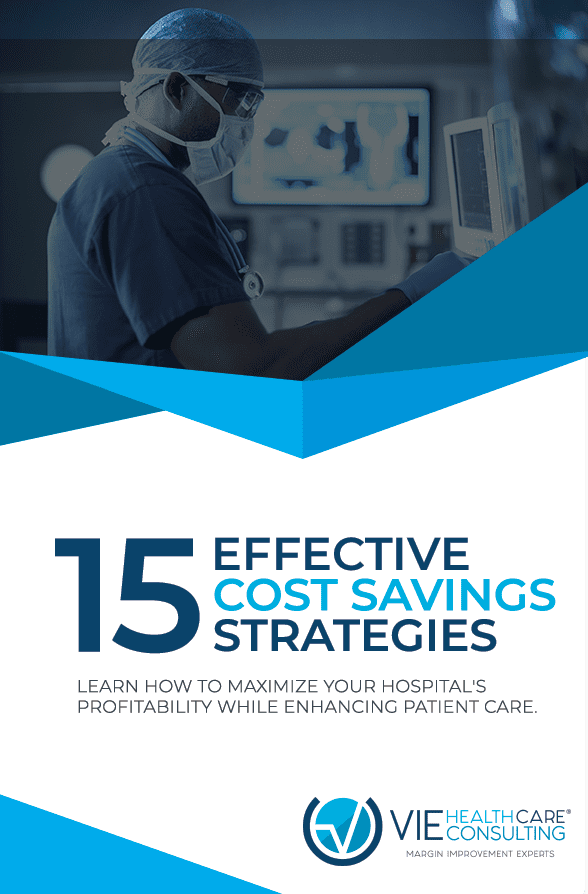3 Structure Foundations to Improve Your Cost
Implementing changes to improve your cost structure to realize savings must be a priority for healthcare leaders.
As the US stands on the cusp of a new era of price transparency, healthcare costs rose to $3.6 trillion in 2018[1], while rural hospitals saw a record number of closures in 2019. [2]
These three foundations to improve your cost structure can help hospitals to implement effective cost reduction strategies in the next twelve months while delivering better patient care.

Increasing physician cost awareness in the OR
The OR is one of the most cost and labor intensive areas in your organization, accounting for an estimated 40% of total hospital expenses and generating 70% of revenue.
On average, hospital costs for stays with OR procedures are double those of inpatient stays that don’t require OR procedures. Identifying cost efficiencies in this key area is an emerging and essential requirement for health systems.
One key strategy is the provision of cost data to surgeons. Research shows that when pricing labels are placed on products in the OR, significant savings can be achieved. In one study, the simple strategy of including prices alongside an implant list resulted in an increase in price awareness among surgeons and cost savings opportunities for the hospital.
These cost savings are achieved without affecting the quality of either patient care or outcomes.
“This straightforward method to raise price awareness among surgeons represents one of the biggest untapped opportunities for cost reduction in the OR.”[3]
Investment in telehealth
For rural hospitals, telehealth offers a lifeline in sustainable cost reduction, enabling patients to receive treatment locally without increasing costs.
In addition:
- Hospitals can offer a wider range of services while improving revenue and enhancing patient care.
- Remote monitoring of patient health can result in better outcomes and reduced costs.
- The patient-doctor relationship is also improved as communication is enhanced.
- Telehealth strategies can enhance the care of patients with chronic disease – currently affecting an estimated 60 percent of Americans.
Find out more about VIE Healthcare’s telehealth solutions for your hospital.
Realize the benefits of spend data analytics
A 2019 study revealed that only 12% of healthcare organizations are effectively using data analytics to manage their costs and enhance patient care. [5]
While the emphasis is on big data sets, it does not exist without small data.
Only 12% of healthcare organizations are effectively using data analytics to manage costs and enhance patient care. Click To Tweet
By incorporating data analytics into your hospital’s strategic plan, it is possible to understand the true costs of care and identify savings opportunities.
VIE Healthcare is a pioneer in innovation in cost reduction strategies.
Our specialty areas include:
Purchased services spend: Dramatic cost savings are often concealed in the “small data” of your purchased services spend, which are only possible to accurately assess by analyzing the line item details of your invoices.
To uncover hidden cost saving opportunities in your purchased services, you must have access to the line item details – the small data – in your invoices. VIE Healthcare’s patented, automated technology, Invoice ROI™, delivers that analysis, offering real-time insight, actionable intelligence and deliverable cost savings.
For more information on how to use purchased services as a leading strategy for cost reduction in your hospital, click here to learn more about these strategies.
Analyze the “small data” in your hospital supply chain: At VIE Healthcare, we focus on bringing transferable best practices from other sectors into healthcare. Supply chain optimization is one of these areas.
A Healthcare Financial Management Association (HFMA) survey found that healthcare leaders are generally in agreement about the value of the supply chain and believe it is possible to improve hospital margins by between 1 to 3%. For a hospital with a 1% profit margin on $900 million in revenues, this could increase supply chain margins by between $9 million and $27 million.[6]
As the supply chain overtakes labor costs as the number one cost in healthcare, margin improvement can be realized by taking a deep dive into your supply chain, extending the analysis of your small data beyond the top 100 vendors to encompass the top 1000. This proven approach enables your hospital to achieve major cost savings through accurate benchmarking.
Furthermore, our analysis and expertise ensure that hospital profit margins and patient outcomes are both preserved and enhanced.
Would you like support to help your hospital achieve its cost savings goals? Schedule a call with Lisa Miller.
[1] https://www.dotmed.com/news/story/49498
[2] https://www.beckershospitalreview.com/finance/rural-hospital-closures-hit-record-high-in-2019-here-s-why.html
[3] https://www.ncbi.nlm.nih.gov/pubmed/28606437
[4] https://www.forbes.com/sites/reenitadas/2019/12/04/top-8-predictions-that-will-disrupt-healthcare-in-2020/#2e1a86147f1e
[5] https://www.managedhealthcareexecutive.com/article/top-4-challenges-healthcare-executives-face-2019/page/0/3
[6] https://www.hfma.org/topics/operations-management/article/healthcare-leaders-agree-about-the-value-of-supply-chain-managem.noauth.html




